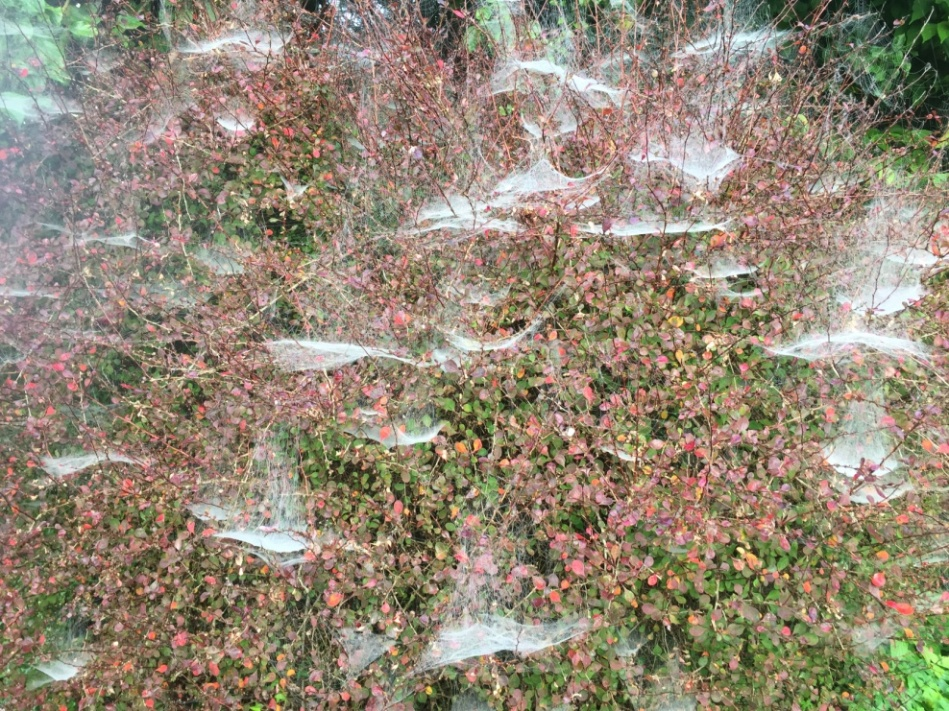Articles
Occasional posts:
- Midsummer and Summer Solstice
Abundance has to be the key-note as we celebrate this Summer Solstice. And what abundance this year! Here at An Gáirdín the trees and hedgerows are laden with fruits and berries.
- The Season of Mists and Webs
September 2024
The season of mists and webs has arrived. This morning was a world of magic webs, so beautiful. Little microcosms of our planet and our universe. Gentle reminders of the interconnectedness of everything. Their fragility and delicacy also calls our attention to the fragility of the great WEB. Their invisibility in the full light of day invites our reflection too.

Spider webs in the morning
- Spotted Flycatcher
August, 2024
Our garden here at An Gáirdín is a habitat for an abundance of birds but a few weeks ago we had a pleasant surprise when we spotted a Spotted Flycatcher (excuse the pun).
- A Few Thoughts on These Post-Solstice Days
When we think back to the Winter Solstice or even the Spring Equinox with the bleakness and darkness of the countryside then, we would have found it a great stretch of the imagination to visualise what we are now in the midst of – the profusion of colour, the swiftness of growth, variety of sounds, plethora of scents and first intimations of a ripening harvest. It all moves us to join our ancestors in acknowledging the great Sun as it unceasingly engages in its elegant dance with Earth, Air and Water.
- Biodiversity Week
“The words still hover, like a seagull battling the wind”
-Michael Viney - Autumn Morning
What a delight to the eyes this hazy, misty autumnal morning – a garden decorated in elegant lace dresses of multiple intricate designs. Those very creative little beings were working hard all night as we were in dreamland. It calls to mind Spike Milligans words:
- Mural
Recently at An Gáirdín we had a delightful ceremony for the unveiling of a mural of The Story of the Universe. This beautiful mural, painted by local artist Izabela Campbell, covers the 14mt back wall of the old cowsheds and barns. For years we had been wondering how we might depict The Story of the Universe in the garden and we are so delighted that Izabela came along and surpassed our imaginations and expectations.
- Brigid, Rushes, and World Wetlands Day
Yesterday we celebrated Brigid. Today we celebrate World Wetlands Day. Is there a connection? Brigid is the great protector of the Land.
- Petrol Free
Here at An Gáirdín we arrived at the stage where we no longer felt at ease with our machines – lawn-mowers, strimmers and hedge cutters. There are probably a few factors which led to our decision to go petrol free in the garden. Perhaps one reason is the same as that which led us to using the ‘no-dig ‘method in the growing area – a heightening awareness of our connection with the soil and of sensitivity to the multiplicity of life there. Also the noise of those machines somehow were an intrusion on the energy and ambience of the place. Then there was, in our case, the unnecessary use of fossil fuel. There is something too about working with one’s hands as opposed to just following a machine.
- Spoonfuls of Sustainability
Our Saturday morning courses entitled A Spoonful of Sustainability was our first venture back after our Covid withdrawal from organising face to face events.
- Lost Treasures
Once upon a time, but not too long ago, from early Spring through to late Autumn our headlands, laneways, roadsides, woodlands, wetlands, bogs and hay meadows were great colourful scenes of diverse flowers. We remember with fondness picking the Mayflower, also known as the Cuckoo flower, for the May altar. We did appreciate them then, but perhaps it is only in their absence that we realise what an idyllic landscape we inhabited. We had more than the beauty of flowers to nourish our spirits. There was also the great diversity of insects and birds that depended on the flowers for survival and on which in turn the flowers depended. The decline in bees and other pollinators at this time is attributed mostly to the decline of wildflowers. And now! ‘Where have all the flowers gone’ and what is it that has happened to us at all? When did our language change? When did we invent the word ‘wildflower’? Was it when the laboratory took a flower from the meadow and manipulated it into a new species? The purpose of course was to sell it and in a relatively short time a major global industry grew up around it. Now we needed a new language, so we coined new words to make the distinction when referring to flowers: ‘cultivated’ and ‘wild.’